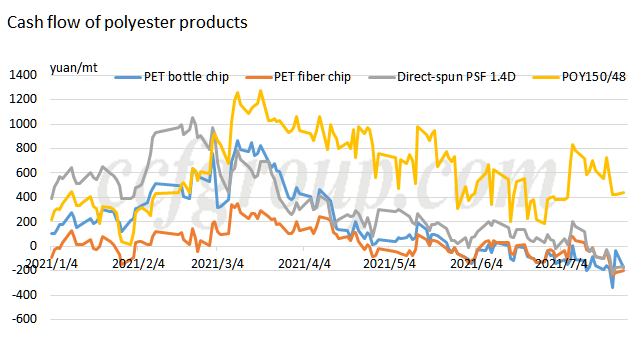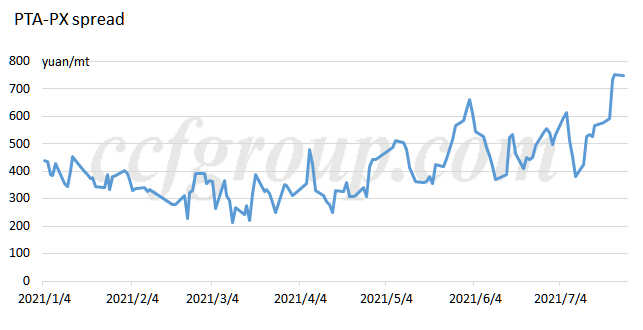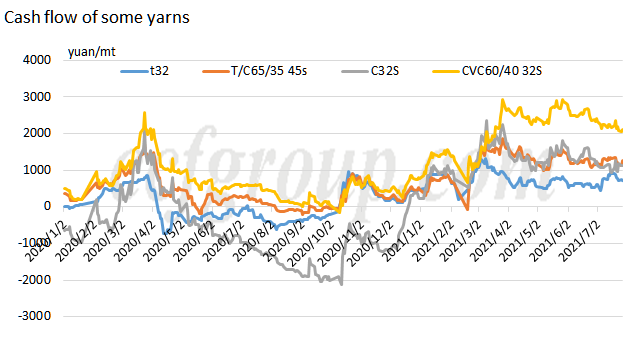What happened to the poor profits of direct-spun PSF?
Direct-spun PSF has witnessed decreasing profits since this year. The cash flow even moved to negative side in Jul.

PET fiber chip and bottle chip seem the same, and PFY performs relatively better. But overall profit is conducted towards upstream.

What are the other reasons behind the weakening profits of direct-spun PSF besides PTA production cut and reduction of contracts volume?
1. Running with high inventory. During this Spring Festival, direct-spun PSF plants kept running at a high rate, resulting in high inventory after the holiday. This situation sustained long coupled with the slump of direct-spun PSF market in Mar. The plants cut production in Apr to Jul, but it only eased previous inventory pressure rather than reversed the supply and demand pattern.
2. Reduced demand, including downstream actual demand and speculative demand.
In terms of downstream actual demand, on the one hand, the demand for nonwoven products plummeted, especially direct-spun PSF for spunlace, causing high inventory in the plants, and some plants shifted production into direct-spun PSF for spinning. On the other hand, in PSF for spinning, the demand for virgin one which had squeezed re-PSF started to return this year as the cost increased. Since the second half of 2017, the price spread between virgin PSF and re-PSF has narrowed under the speculation of the ban on re-PET import, and virgin PSF kept snatching re-PSF. In addition, the occupation to cotton also reduced. In the past years, cotton yarn mills partly transferred to produce polyester/cotton yarn due to losses, increasing the demand for direct-spun PSF. However, cotton yarn demand was driven to be strong by the orders of home textile and orders from Southeast Asia since last Oct and polyester/cotton yarn production was shifted back.

The speculative demand is reflected in the hoarding demand of downstream consumers, spot-futures traders and traditional traders. Looking at downstream users, the demand for nonwoven products soared last year and all links have hoarded up, while this year it is bearish. As for the traders, both spot-futures traders and traditional traders were active in procurement since PSF futures was listed last Oct, but after this Mar, they sold quickly and rarely restocked from the second quarter this year.
The supply and demand situation hinders direct-spun PSF to move up quickly. However, that of polyester yarn is relatively healthy. Ring-spun polyester yarn has stayed in the period of overcapacity cut in previous years, and affected by the epidemic, the textile orders of some countries have flown back to China, leading to tight supply and higher profit. But fabric price is hard to improve. Therefore, polyester yarn mills are reluctant to accept high-priced PSF as the cost is hard to transfer quickly and effectively.
In conclusion, only the supply and demand pattern reverses largely, can direct-spun PSF market have a breakthrough. But as things stand, the production cut of direct-spun PSF plants is disperse, so it still depends on the outburst of end-user demand.
- Top keywords
- Cotton Price
- Cotton Futures Price
- Cotton Futures
- CZCE
- PTA Futures Price
- Chemical Fiber
- Polyester Prices
- Wool price
- PTA Futures
- Shengze Silk
- China
- Yarn Price
- price
- China Textile City
- Fibre Price
- Benzene Price
- Cotton
- Index
- Cotton Index
- PTA
- fabric price
- NYMEX
- Top 10
- textile industry
- Spot Cotton
- Cotton Yarn
- Polyester Price
- Futures
- PTA Price
- cotton yarn price

